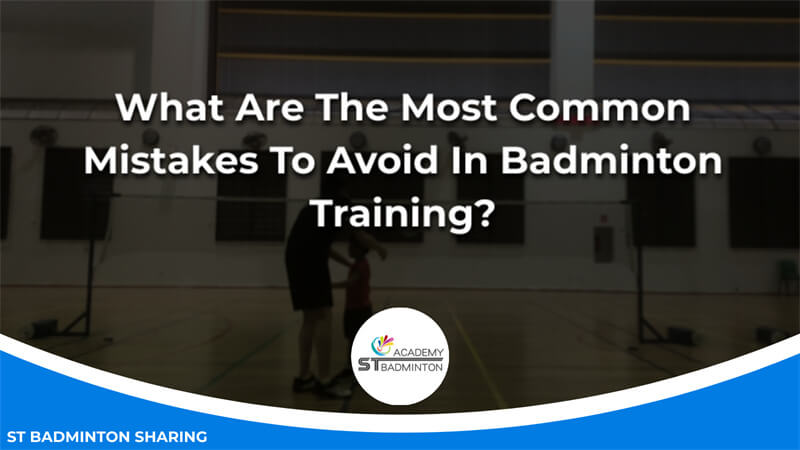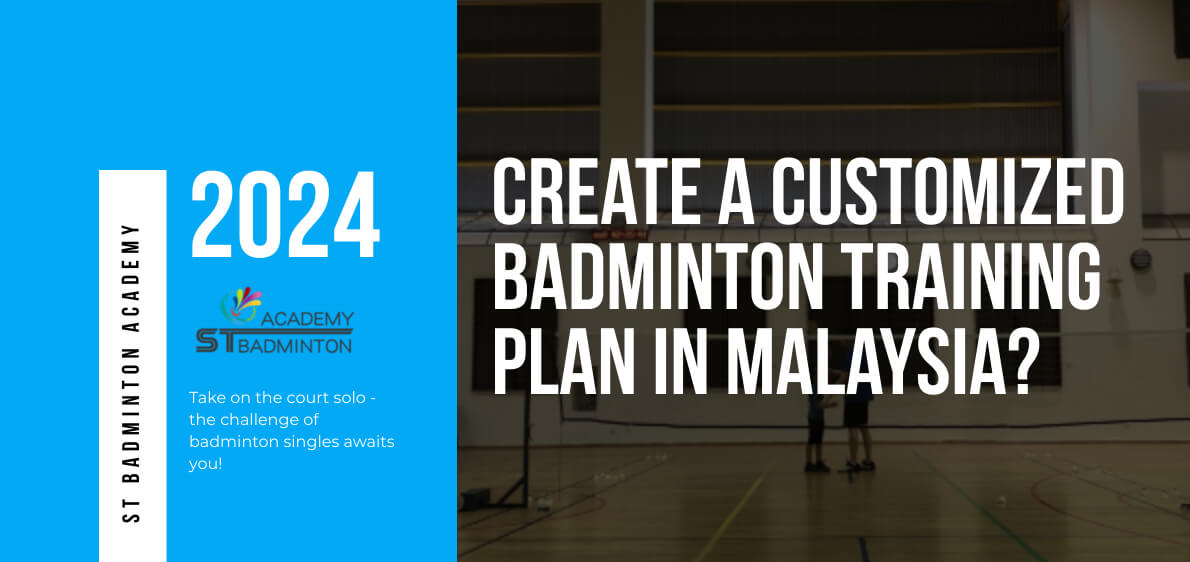Welcome to ST Badminton Academy’s badminton training in Malaysia! I’m here to talk about the most common mistakes people make when it comes to their badminton training. If you’re serious about improving your skills on the court, then you need to be aware of these issues so that you can avoid them at all costs. In this article, I’ll discuss what some of those errors are and give advice on how to best address them. So if you want to up your game, read on!
Not Having A Set Training Plan
It’s no secret that badminton is an incredibly challenging sport, but if you want to be successful in it, having a set training plan is essential. Unfortunately, statistics indicate that up to 80 percent of players don’t have one! This can lead to some common mistakes such as ignoring technique and neglecting form.
Training without any sort of structure isn’t just ineffective; it’s actually detrimental to your performance. Without being aware of the correct techniques, you won’t be able to maximize your potential or get better at the game. Additionally, disregarding proper form will not only make you slower on the court but also increase your risk for injury.
If you want to become skilled at badminton, then creating a structured plan and committing to it is key. Not doing so means risking stagnation and even regression in terms of skill level – neither of which are desirable outcomes when trying to reach excellence in this difficult and demanding sport. Moving forward with consistent practice is essential for mastering all aspects of badminton from footwork and agility drills to practicing serve intensity.
Not Being Consistent With Practice
Having a set training plan is essential for any badminton athlete, but the next mistake to avoid in badminton training focuses on consistency. Without consistent practice and repetition of skills, it’s almost impossible to achieve success in this high-intensity sport.
Tracking progress is key when evaluating performance—you must continually assess your technique and push yourself beyond your limits if you want to reach that championship level. Therefore, having a plan and executing it regularly is vital to achieving desired results.
It’s easy to make excuses about why you can’t commit time or energy towards honing your craft, especially with such a demanding lifestyle; however, making small improvements over time will yield massive results down the road.
Instead of trying to cram all of your improvement into one session or day, allotting short chunks of focused attention throughout the week allows athletes to effectively build their skill set without sacrificing too much time from other priorities. Taking five minutes each day just to review your form could be enough time for major breakthroughs.
When it comes improving as an athlete, there needs to be commitment even through periods of stagnation because true growth requires taking risks outside our comfort zone and constantly striving for betterment.
The only way to get ahead is by being proactive not reactive; whether its watching instructional videos online or reviewing game footage with coaches/teammates – little steps add up quickly!
To conclude, don’t underestimate the importance of making a commitment toward long-term improvement instead of focusing solely on quick fixes and immediate gratification. This kind of mentality will serve you well in those late stages of tournaments when fatigue sets in – staying strong mentally gives players the edge they need most during competitive matches.
Not Making A Commitment To Improvement
One of the most common mistakes to avoid in badminton training is overlooking technique. It can be easy for a player to become focused on winning and taking shortcuts, but this can lead to long-term problems with your performance.
For example:
| Impact of Neglecting Fundamentals | Consequence |
|---|---|
| Skipping Footwork Mastery | Neglecting proper footwork can significantly diminish your court coverage, limiting your reach during rallies. Mastery of footwork is essential for maneuvering swiftly, reaching shots effectively, and maintaining optimal positioning on the court. |
| Neglecting Racket Grip Learning | Failing to learn the correct way to grip a racket can adversely affect both accuracy and power in shot execution. Proper racket grip is fundamental to control and generate power, ensuring shots are delivered with precision and force. |
| Ignoring Basic Fundamentals (e.g., Body Positioning in Swings or Jump Smashes) | Ignoring fundamental aspects such as body positioning during swings or jump smashes may lead to improper form. This lack of attention to basics not only hampers performance but also poses the risk of injury due to inadequate technique and strain on the body. |
This example illustrates how neglecting key badminton fundamentals, such as footwork, racket grip, and body positioning, can have significant consequences on court coverage, shot accuracy and power, and even physical well-being.
It’s important not to overlook these essential technical skills as they are necessary for building solid foundations that you’ll need if you want to continue improving over time. Making sure that you focus on perfecting the basics before moving on to more advanced strategies will help ensure success both now and later down the line.
Additionally, it’s beneficial to seek feedback from coaches, teachers, and other experienced players who can provide valuable insight into areas that may benefit from improvement. Other than choosing a good racket and also remember to choose the best racket restring in Malaysia.
Stretching before and after training sessions is an essential part of any athlete’s routine as it helps prevent injuries, improves flexibility, and increases range of motion which are all important elements of badminton playability.
Not Adequately Stretching Before And After Training Sessions
One of the most common mistakes made in badminton training is skipping warm-ups and stretching before and after each session. This can cause serious injuries, as well as reducing performance levels significantly due to lack of flexibility.
Stretching helps players prepare for intense physical activity and reduces soreness afterwards. It’s important to incorporate dynamic stretches that increase blood circulation throughout your body prior to exercising, followed by static stretches focusing on specific muscle groups involved with playing badminton.
| Dynamic | Static |
|---|---|
| Jumping Jacks | Hamstring Stretch |
| High Knees | Quadriceps Stretch |
| Butt Kickers | Calf Stretch |
Another mistake in badminton training is ignoring technique when practicing or competing. Poor form not only increases the risk of injury but also affects an individual’s ability to generate power through their shots. Instead, focus on perfecting techniques such as footwork drills and proper grip while hitting forehands and backhands correctly. Ensure you spend time learning how different grips affect shot placement and accuracy too so you can react quickly against opponents.
Having a good understanding of the basic theory behind strokes will help you become successful during matches as it allows you to be more prepared than your opponent – both mentally and technically speaking. Taking part in game-based drills which simulate real match scenarios are beneficial for developing strategy, hand-eye coordination, agility, reflexes, and overall match awareness without having to solely rely on strength or speed alone.
Not Working On Your Weaknesses
It’s easy to think that, when training for badminton, the only way to get better is to hit harder and faster. However, this couldn’t be further from the truth. If you overlook fundamentals and ignore technique in your training sessions, then no matter how hard or fast you hit the shuttlecock, it won’t make much difference.
The key to becoming a great badminton player lies in mastering the basics – getting your footwork right and understanding proper body mechanics. You might have heard stories of players who don’t practice their skills but still manage to win matches; however, these are few and far between! Most successful players understand that repetition is key when it comes to improving your game – by honing those crucial fundamental skills over and over again until they become second nature.
Not focusing on your weaknesses can also be detrimental; if there’s an area of your game that needs improvement, then work on it with determination so that you become more well-rounded as a player overall.
That said, always try to keep things enjoyable too – nobody likes forcing themselves through drills every day! By finding ways to stay motivated while working on problem areas, you’ll soon start seeing improvements in all aspects of your play. Now let’s focus on not working on our footwork…
Not Working On Your Footwork
It’s easy to focus only on your strengths when it comes to badminton training. However, if you want to reach the next level in the sport and stay competitive, you need to work on improving your weaknesses as well. Here are some common mistakes that should be avoided if you want to improve:
| Common Mistakes in Badminton Training and Improvement Tips | Avoidance Tips |
|---|---|
| Not Staying Motivated | – Maintain focus and motivation throughout training sessions. – Set goals to keep yourself inspired. – Create a playlist of upbeat music to enhance your energy during workouts. |
| Improper Technique | – Observe other players’ styles during practice. – Refine your technique to ensure clean and powerful shots. – Be aware of any inefficient movements that may have resulted from poor techniques. |
| Ignoring Footwork | – Recognize the importance of footwork drills in badminton workouts. – Incorporate exercises like running and jumping rope to strengthen lower body muscles. – Practice specific footwork patterns to develop agility, balance, coordination, and speed for success on the court. – Make footwork a second-nature aspect of your gameplay. |
This advice emphasizes the significance of staying motivated, addressing improper techniques, and prioritizing footwork in badminton training to enhance overall performance and reach the next level in the sport.
Being aware of these common mistakes will ensure that every minute spent training is used effectively towards reaching higher levels of play in badminton while avoiding unnecessary injuries along the way. Taking regular rest days is also key in order to give your body enough time between workouts so that you can perform optimally during each session.
Not Taking Rest Days
I cannot emphasize enough how crucial it is to avoid the mistake of skipping warm-up and overtraining during badminton training. It’s like walking through a minefield – one wrong step and you could be out for weeks if not months! There’s no exaggeration when I say that these two mistakes are catastrophic for any serious athlete looking to take their game up a notch.
First off, let me tell you this: never ever underestimate the power of warming up before beginning your session. A good warm-up prepares both your mind and body for intensive exercise; it gets your muscles ready so they don’t suffer from strain or fatigue and gives you an opportunity to practice technique without risking injury. Skipping warm-ups will only set you back in terms of progress and increase the chances of getting injured – something no athlete wants!
And then there’s overtraining, another huge blunder many players make. Sure, pushing yourself hard can bring great rewards but going too hard too fast can lead to burnout, exhaustion, and injuries as well as have a negative impact on performance levels.
So always remember to pace yourself properly; give yourself enough rest days between intense sessions, eat right, and hydrate often to keep energy levels high throughout training. Without proper maintenance, all those hours spent honing your skills will go down the drain quicker than you think!
Not Eating Properly
Having discussed the importance of taking rest days for a successful badminton training program, let’s now focus on another common mistake: not eating properly. Proper nutrition is essential to any athlete’s performance, and badminton is no exception.
Eating too much or eating unhealthy food can lead to fatigue, weight gain, and an overall decrease in performance. On the other hand, following an appropriate diet with proper portions will help you build muscle and increase endurance during your matches.
Here are some tips to follow when it comes to eating right while training for badminton:
| Tips for Proper Nutrition During Badminton Training | Guidelines |
|---|---|
| Eat Smaller, Frequent Meals | – Consume smaller meals throughout the day to maintain consistent energy levels during badminton training. – This prevents feelings of sluggishness on the court. |
| Focus on Nutrient-Rich Foods | – Prioritize nutrient-rich foods, including lean proteins, fruits, vegetables, whole grains, healthy fats, and dairy products like yogurt and milk. – These provide essential vitamins and minerals, sustaining energy levels during workouts. |
| Avoid Overeating and Junk Foods | – Steer clear of overeating and refrain from snacking on low-nutrient foods like chips and candy bars. – These foods contribute to excess calories and offer little nutritional value, potentially leading to weight gain. |
| Limit Alcohol Intake | – Restrict alcohol consumption as it can disrupt sleep patterns and negatively impact physical performance due to dehydration. – Maintaining proper hydration is crucial for optimal athletic performance. |
It is also important to avoid overtraining by getting adequate rest between training sessions. If you find yourself feeling fatigued after long practice sessions or competitions then make sure you take at least one day off from playing each week in order to allow your body time to recover before returning back onto the court again refreshed and ready for action!
Frequently Asked Questions

How Long Should I Rest Between Badminton Training Sessions?
When it comes to badminton training, the length of time between sessions is important. Ideally, you should rest for at least 48 hours after each practice session in order to allow your muscles and joints to recover.
This will help prevent injuries and ensure that you’re able to perform at your best during every match or tournament. Additionally, taking breaks allows you to focus on alternative drills and playing strategies so that your game can continue to improve.
What Is The Ideal Diet For A Badminton Player?
As a badminton training expert, I always recommend that my players have an ideal diet to maximize their performance. Maintaining good hydration levels and ensuring adequate nutrition is essential for any athlete. Having the right fuel before and after each session is key to achieving optimal results.
A balanced meal should include complex carbohydrates like whole grains, lean proteins such as fish or poultry, healthy fats from nuts or avocados, and plenty of fruits and vegetables to ensure you’re getting all the necessary vitamins and minerals. Proper nutrition will help provide energy for practice sessions and give your body what it needs to recover quickly afterward.
What Is The Best Way To Stretch Before And After A Badminton Session?
Stretching before and after a badminton session is essential for improving your performance, preventing injuries, and helping you recover. To get the most out of your stretches, make sure to maintain proper form while doing technical drills. Start with dynamic stretching such as arm circles or ankle rotations to help warm up your muscles and increase flexibility.
Once done, move on to static exercises like leg swings or shoulder rolls that will focus on specific areas of the body used during play. Make sure to also spend some time focusing on cooling down by stretching all major muscle groups using both active and passive techniques. By combining these methods together, you’ll maximize your badminton training sessions without risking injury!
How Often Should I Be Practicing Badminton To Improve?
Practicing badminton regularly is essential to improve your skills and so you’ll need to create a training schedule that works for you. Depending on how much time you have available, two or three sessions of 45 minutes each week should be enough to work on both the physical and mental aspects.
Make sure your body mechanics are correct during these practices as this will help with executing shots more efficiently; also focus on developing good habits in terms of anticipation, footwork, and court positioning. Lastly, pay attention to your mental focus by visualizing yourself playing at higher levels and working through scenarios in which you can test out different techniques.
What Are Some Exercises I Can Do To Strengthen My Footwork For Badminton?
Footwork is one of the most important parts of badminton training and strengthening it can make all the difference in your game. Think about it like a dance: each step must be precise and measured, with proper technique and mental focus to stay on top of your opponents.
I recommend exercises such as quick feet drills, skipping rope, side steps with shuffles, squat jumps, and lateral bounds for building agility and strength in both legs. These will help you develop coordination so that you’ll have the footwork necessary to take your game up a notch.
Learn Effective Badminton Training in Malaysia
As a badminton training expert, I can tell you that there are many common mistakes to avoid in order to ensure your badminton sessions are effective. From not resting enough between sessions, to not eating the right foods or stretching properly before and after each session, these mistakes can hinder your progress and success as a player.
Taking time for yourself is essential; rest the body, fuel it with nutritious meals, stretch the muscles, and practice consistently – this will help create a strong foundation for long-term success. By avoiding these errors, you’ll be able to maximize your potential and ultimately achieve the results you desire – no matter what level of play you may be at!





